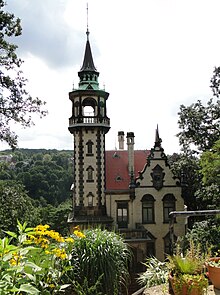Villa San Remo
The Villa San Remo is one of the most extravagant villa buildings in the Loschwitz district of Dresden . The building at Bergbahnstraße 12, right next to the Luisenhof and the funicular , is a listed building .
history
The Villa San Remo was built around 1895 according to a design by F. Berghold in the neo-renaissance style. The first inhabitant of the villa is said to have been the Saxon Crown Princess Luise of Austria-Tuscany , who may also have commissioned the construction of the villa. The building later became the property of the manufacturer Kurt Vogel, who sold the villa to Charles A. Noble in 1938 . Noble, who emigrated to America in 1921, took American citizenship and, after returning to Germany, developed the Praktiflex SLR camera (later Praktica ), lived here with his wife, son John H. Noble, and his sister's family.
After the end of World War II , Charles and John H. Noble were arrested on the pretext that they had raised the American flag on the tower of Villa San Remo when the Soviet troops marched in. Both were sentenced to several years in prison. After John H. Noble was released from prison in 1955, the former Prime Minister of Saxony, Max Seydewitz, first spread the so-called "Noble legend" in newspaper articles and later in his book The Invincible City : The nobles had spied the allied bombers on April 13th. In February 1945 it was piloted to the city via a transmitter station in the villa high above the Dresden Elbe valley, thus initiating the bombing of Dresden . Other versions claimed that Charles Noble used a reflective mirror to guide bomber pilots towards the city from the tower of Villa San Remo. The baseless accusation led to the expropriation of the Noble family, who also lost the Villa San Remo.
The villa became the property of the city and was initially used as a guest house for the city of Dresden. Later there was a clubhouse in the rooms and finally the HO data center. Until 1989 there was a plaque on the building that reported the alleged "atrocity of the nobles". After the fall of the Wall , John H. Noble got the Villa San Remo back as property in 1991. The villa was auctioned in 2002 and has been inhabited again since 2006.
Since 2013, a Halloween party has been held on October 31st together with DVB AG (Dresdner Verkehrsbetriebe AG) in the outdoor area of the villa. Visitors are guided through the outdoor area in small groups. There are several stations where the visitors are sometimes frightened. The Lions Club New Century Dresden plays a leading role. Visitors pay a small contribution towards expenses. The net proceeds go to a social project. This event is now one of the largest in Dresden. The term "largest horror garden in Germany" has meanwhile established itself.
In Uwe Tellkamp's 2008 novel Der Turm , Villa San Remo appears under the name Rapallo .
construction
The Villa San Remo is considered to be one of the “most exalted buildings on the White Deer ”. It was "built on a steep hillside ..." so that the 2800 square meter property is not accessible. The building was built in the neo-renaissance style. The high tower, which is accessible and has a viewing platform, is particularly striking. Like all other towers and dormers in the villa, the lantern is covered with copper. The tower positioned at the left corner of the portal side is juxtaposed with a corner projecting with a curved gable. There is a small window with a round exit. The entrance porch placed between the tower and the risalit consists of a balcony terrace resting on columns. The materials used for the facade are rather untypical for Dresden. Although all architectural parts were made of Saxon sandstone, the surfaces were clad with white bricks. "The rationality of ... modernity countered [the design of the villa] in romanticizing transformations, the actual usefulness of which is often limited to the symbolic".
literature
- Villa San Remo. In: Julia Franke, Clemens Niedenthal: Country houses & villas in Dresden. Volume 1: White Deer . Aschenbeck & Holstein, Delmenhorst and Berlin 2006, ISBN 978-3-939401-16-2 , pp. 16-17 .
- Villa San Remo. In: Matthias Donath , Jörg Blobelt : Old & New Dresden . edition Sächsische Zeitung, Dresden 2007, ISBN 978-3-938325-41-4 , p. 154 f .
Individual evidence
- ^ Dresden themed city map , accessed on August 28, 2019.
- ↑ a b c Franke, Niedenthal: Villa San Remo , p. 16.
- ↑ Max Seydewitz: The invincible city . 6th edition. Brockhaus, Leipzig 1982, p. 189 (1st edition = Congress, Berlin 1955).
- ^ Stadtspiele-Verlag, Stadtverführer Dresden: Villa San Remo ( Memento from August 18, 2016 in the Internet Archive ).
- ↑ Bergbahnstraße on dresdner-stadtteile.de, accessed on August 28, 2019.
- ↑ The Noble Legende on john-noble.de, accessed on August 28, 2019.
- ↑ Luise's fairytale castle. In: Welt Online, August 31, 2002.
- ^ Andreas Platthaus: Time difference: Uwe Tellkamps Dresden . In: FAZ.NET, October 6, 2008.
- ↑ Georg Dehio (ed.): Handbook of German Art Monuments. Dresden . Updated edition. Deutscher Kunstverlag, Munich and Berlin 2005, p. 183.
- ^ Donath, Blobelt: Villa San Remo , p. 155.
Coordinates: 51 ° 3 '28.3 " N , 13 ° 49' 9.6" E

